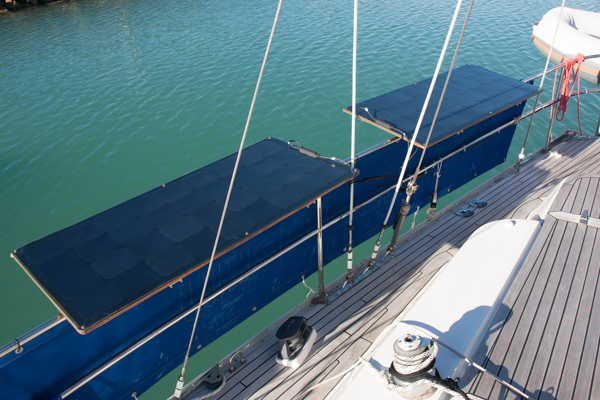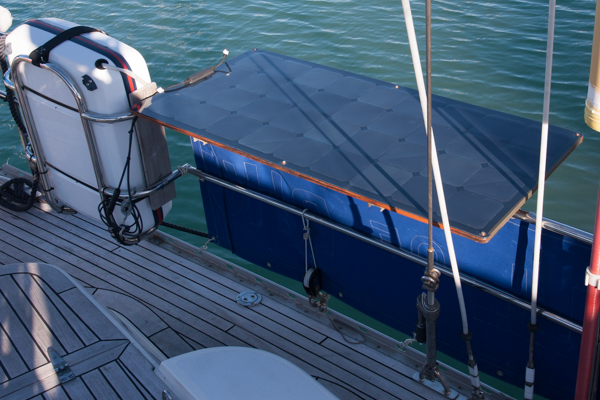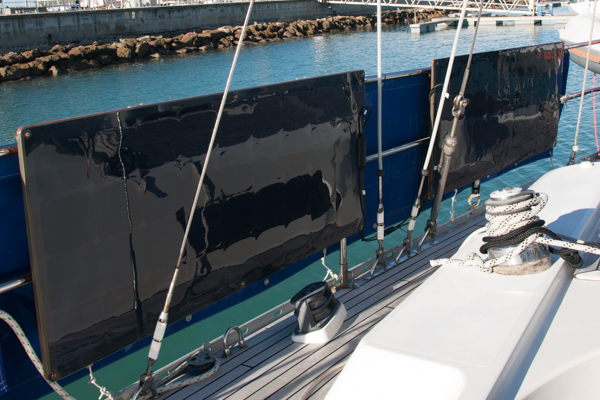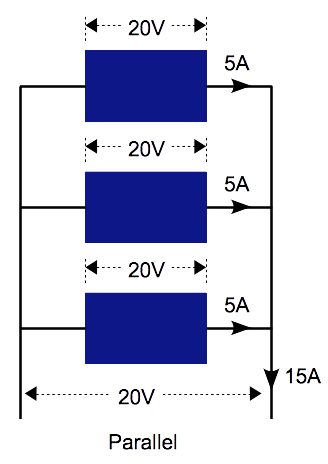Solar Panels on Speedwell
When we originally refitted Speedwell we added a couple of small (17W) solar panels on the coachroof and a wind generator on the mizzen mast. After our wind generator destroyed itself our only renewables were the small coachroof solar panels, we found that due to their location normally only one of them was in full sunshine so we rarely got more than 1A from this installation.
We did consider replacing our wind generator, but the mounting that we had was specifically sized for a Rutland unit and we didn’t feel comfortable fitting another one of these. All of the wind generators that we could find who’s manufacturers were prepared to guarantee high wind survival were too large for our existing mounting, so we decided to remove the mount and instead go for a larger solar installation.
Installation
The first question was where to mount the panels. We considered some sort of gantry at the stern of the boat, but it would have been difficult to arrange this clear of the mizzen sail. Instead we had our pushpit extended to the side boarding gates, giving us reasonably long runs of stainless steal tubing around the aft deck to which we could fit our panels.
The panel size was determined by the space that we had available. We found that we could fit 3 100W panels on our rails, two on the starboard side and one to port (our liferaft is mounted inset into the port side railings so there’s less free space on that side). We chose semi-flexible panels rather than rigid ones as overall they were thinner and seemed to be a little more robust (no worries about cracking the glass), there was no difference in the quoted performance of the two options. Each panel is bolted to a plywood frame which in turn is bolted to a pair of NOA rail mounts, these allow the panel to be tilted and slid in and out, so we can fold the panels away when we’re in harbour.




Our panel installation generally works well. We have to remember to fold the panels away before going into an along side berth, but that’s just part of general boat preparation along with getting the warps and fenders out. At anchor or on a mooring we need to be careful when harbourmasters or customs officials visit so that they don’t hit a protruding panel when coming alongside. If we’d gone for the gantry mounted option this wouldn’t have been an issue.
Regulation
Anything but the smallest photovoltaic (PV) solar installation needs to be connected to the batteries through a regulator. The regulator controls the amount of current flowing into the batteries to ensure that they charge correctly and that the battery voltage is kept within the correct range. The more sophisticated units operate multi-stage charging schemes that aim to keep the batteries in the best possible state of charge.
There are two main types of regulator:
- Pulse width modulation (PWM). These turn the connection between the panels and the batteries rapidly on and off to control the amount of charge flowing. This means that the panels operate at the battery voltage, so the array needs a nominal output voltage that is a little more than the battery voltage (typically 18V to 20V open circuit voltage for a 12V battery). The input voltage limitation means that multiple panels need to be wired in parallel.
- Maximum power point tracking (MPPT). These contain voltage conversion circuitry so that they can run the panels at a different voltage to the battery. The controller then adjusts the panel voltage, depending on the amount of light falling on them so that they are running at their maximum efficiency (the maximum power point) allowing more power to be extracted than a PWM regulator would manage. Manufacturers typically claim up to 30% better efficiency for MPPT compared to PWM. A further advantage of the voltage conversion built into an MPPT controller is that some units are able to accept considerably higher panel voltages compared to the battery voltage, which gives the option of cabling multiple panels in series.


Our PV installation is constrained by space rather than cost, so the extra expense of an MPPT regulator was worthwhile to ensure that we get the most from our panels. We fitted a Victron BlueSolar MPPT regulator, which is able to accept up to 100V on the PV side. Each of our 3 solar panels has an open circuit output voltage (the maximum it will produce) of 21V, so the three of them in series generate at most 63V, comfortably below the maximum input voltage of the regulator.
Using a series connection the maximum current from our array is around 5A (300W at 60V), so we were able to use a relatively light gauge of cable for the run from the panels to the regulator without suffering a significant voltage drop. This helped with routing the cables through the boat.
Monitoring
Speedwell was originally fitted with a Mobitronic battery monitor that counts up current flow into and out of the batteries to estimate their state of charge. During the 2009/10 refit we fitted a more sophisticated Victron battery monitor but kept the old Mobitronic unit in the electrical panel. The Mobitronic is now wired in between our solar controllers (the one for the new 300W installation and the ones for the two small coachroof panels) and the batteries so we’re able to monitor the amount of charge that we get from our PV system.

Sizing the System
The amount of charge that we get from the PV system over the course of a day depends on the output from the panels but also on the state of charge of the batteries, the electrical loads that are running and any additional charging from engine running.
If the regulator is able to get the batteries up to full charge then it will reduce the power that it takes from the panels as it moves into absorption then float charging modes. On a day with no engine running, if the system is perfectly sized then it will be moving to float charging in the late afternoon as the available sunlight comes to an end. In this case a larger PV installation will simply get to float charge earlier in the day, any potential additional charge that the array could provide after that point will not be used.
If the system is under-size then it will not be able to bring the batteries up to full charge over the course of a day so that after several days it will be necessary to use some additional charging (the main engine, a generator or shore power) to ensure that the battery charge doesn’t drop too low. Even so such a system is still useful in extending the time between battery charging, helping to reduce engine hours, and could well be sufficient to handle the smaller loads that there will be when the boat is left untended.
Of course in practice the amount of charge that the array generates will vary depending on cloud cover, the time of year and the latitude that the boat is in. The state of charge of the batteries will vary depending on what loads have been run and on whether or not they reached full charge on the previous day. But whether or not the system is getting to float charge by the end of most days is a good guide to how well it is keeping up with electrical demands onboard.
Practical Experience
Speedwell has an all 12V DC power system. For a 24V system with a similar PV setup the Ampere Hour values would be half of those that we measured.
While we’re living on the boat our fridge is on continuously. We run lighting as needed and also have a 1500VA inverter that we use to charge our laptops, run the sewing machine and occasionally run an induction hob. If we’ve been using our Torqeedo electric outboard then we re-charge that from the main batteries. When we’re sailing we also run our instruments, navigation lights and radar as needed, and our auto-pilot.
At anchor in Ireland in June with typical overcast showery weather our system was generating around 30AH per day. That’s not enough to fully charge the batteries when we’re living aboard, but it did help to extend the time that we could last without additional charging and we were moving on frequently enough that normal engine running would bring the batteries up to full charge.
In the Algarve in early September with full sunshine most days the regulator was normally in float charge by the end of the day, so the system was getting the batteries up to full charge and not using all of the energy that was available from the panels. Depending on the initial state of the batteries the PV system was providing up to a little over 100AH over the course of a day. We had enough energy from the solar system to be able to run our portable induction hob from our inverter for some of our cooking, saving on gas.
We had mixed sailing conditions this year, with a mixture of sailing and motoring. As a result there were not many occasions when we sailed for over 24 hours without using the engine. However we did find that on a sunny day the PV system was generating enough power to run all of the instruments, the fridge and the auto-pilot with a few amps to spare for battery charging. I don’t think that the day time charging was sufficient to fully cover overnight electricity usage so over a multi-day passage it wouldn’t keep up with demand, but it would certainly extend the number of days between running the engine for battery charging.
Shading
The output of a solar panel reduces if part of the panel is in shade. When a number of panels are connected together, either in parallel or a series chain, then it’s possible for shading of one panel to reduce the output of the other panels as well, although modern panels have features like bypass diodes that help to reduce this effect.
Our panels are spread over both sides of the boat, on either side of the mizzen mast, so there are various pieces of rigging and sails that can cast a shadow on part of at least one panel depending on where the sun is. Our installation makes this sort of shading more likely than it would be with panels on a stern gantry.

As expected, when a panel is partially shaded we do see a reduction in the current that the array delivers, however we don’t see really large drops, so our system is coping well with shading. At least in part this robustness is probably due to our use of an MPPT regulator, which is able to adjust the operating point of the array to best cope with the effects of shading.
When fitting a system you should of course do your best to ensure that the panels receive as little shading as possible. But on a sailing boat there will never be a location that guarantees no shading. Our experience is that with modern panels and controllers partial shading is not as much of a problem as it may once have been.
Practice vs Theory
A common guide to estimating the energy that a solar array will generate over the course of a sunny day is to assume full power output for 5 hours.
Over 5 hours at full power our 300W array would be expected to generate 1500WH. For a 12V system the batteries actually need between 13V and 14V to charge (depending on the charging mode that the regulator is currently in) so assuming an average charging voltage of 13.5V, 300W would be 111AH. That figure assumes that the charging system is 100% efficient, of course in practice this is not the case. Allowing 10% for losses in the regulator and cabling gives 100AH per day, which is what roughly what we were seeing on a sunny day in southern Portugal when the batteries were in a state that allowed them to accept that much charge.
Living with an all Solar System
Our experience of a larger solar installation, with no wind generator, has been positive.
We get power from our solar system every day regardless of wind strength, although the amount is reduced when it’s cloudy and of course there’s no power generation at night.
The PV system is completely silent. We used to turn our mizzen mounted wind generator off at night to stop the noise that it transmitted down the mast from keeping us awake.
A reasonable size wind turbine has the potential to generate more current that our PV system’s peak output, but that is only in relatively strong winds. While a wind turbine has the potential to generate a lot of power in strong winds it produces much less in light winds so day to day output is more variable than a PV system.
As an aside, wind turbine power output graphs frequently quote wind speed in m/s. 1m/s is 1.9kts so you have to roughly double the quoted numbers to get wind speed in units that make more sense to sailors. A generator that claims 100W output at a modest sounding 10m/s needs a constant 19kts, the top end of a force 5, to generate that much power.
We’re happy with the renewable power generation that we’ve now got installed. It keeps up with our consumption most of the time. In sunny summer weather we can keep our batteries fully charged at anchor. Under sail we’d need some additional charging to manage a long ocean crossing without occasional engine running, but I don’t think that the additional cost of that would justify the small saving in engine hours and fuel.